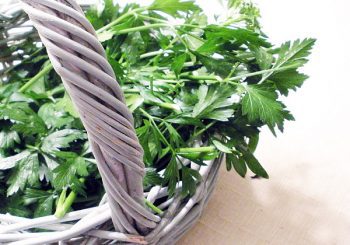By Sayer Ji
Contributing writer for Wake Up World
Parsley is often used as a flavoring among the chopped greens in your salad and makes a rich addition to sauces for juicy steaks, or a trusty garnish on your favorite dishes.
However, it’s also a veritable medicine sitting in your pantry, perhaps as juice to relieve edema or a powerful antioxidant source. The possibilities are endless with Petroselinum crispum, an important culinary herb originating from the Mediterranean region.
[pro_ad_display_adzone id=”110028″]
Parsley contains a formidable lineup of constituents such as coumarins, carotenoids, ascorbic acids and flavonoids for a wide range of health uses. These constituents give parsley plenty of wellness benefits, from being antimicrobial and diuretic to antihypertensive and anticoagulant.[i]
In fact, it’s used in Morocco mostly as an elixir to treat arterial hypertension, diabetes, and cardiac and renal disorders. Here are some of the top benefits of parsley for better health.
1. Rich Nutrient Source
Parsley is a nutrient-dense food. A one-cup serving (60 grams) of fresh parsley provides 22 calories, 3.8 grams (g) of carbohydrates, 1.8 g of protein, 2 g of dietary fiber, 3.72 milligrams (mg) of iron or 22% of the reference daily intake, 332 mg of potassium or 7% of RDI, 79.8 mg of vitamin C and 82.8 mg of calcium.[ii]
Parsley can be used in many flexible forms as part of a healthy diet. You may add fresh parsley to your dressings, sauces and marinades, or simply chop a few sprigs to garnish meals or add the herb to the dish by the end of its cooking time.
You may dry your fresh parsley, too. Tie a bunch together, then hang it upside down in a cool and dry place.[iii] Once completely dry, remove the stems and store the leaves in an airtight container. You may also use a dehydrator or a slightly warm oven. Why not also use the herb as a natural breath freshener? It’s a proven folk remedy against halitosis in a number of places including Italy.[iv]
Parsley can be part of your own home garden; seeds can be planted outdoors in March or April, depending on your growing season, or in late summer for early growth the next spring.
2. Full of Antioxidants
Parsley is chock full of potent antioxidants, which are compounds that prevent cellular damage from free radicals and are required by the body to maintain optimal health.[v] Parsley and celery juices successfully restored antioxidant activity in animal models treated with the chemotherapy drug doxorubicin.[vi]
Further studies show that diets rich in antioxidants such as flavonoids may slash the risk of diseases, including colon cancer.[vii] And as oxidative stress plays a principal role in stress-induced gastric injury, parsley offers antioxidants such as flavonoids, carotenoids and ascorbic acid to combat it.[viii] It might interest you to know that dried parsley appeared in a study to be more antioxidant-rich than its fresh counterpart.[ix]
3. Antidiabetic Action
Many medicinal herbs and spices have been traditionally celebrated for helping to control glucose levels with minimal to no side effects.
Along with Egyptian balsam, parsley extract was found to exhibit antidiabetic and antioxidant properties in Type 1 diabetes mellitus cases.[x] The herbal preparations were found to significantly reduce mean blood glucose levels and significantly increase insulin and total antioxidant capacity in the treated diabetic groups versus the control group.
In a Turkish study, researchers found that parsley had a significant hepatoprotective effect in diabetic animal models, where those treated with the herb demonstrated substantially lower levels of blood glucose, among other markers.[xi]
In similar findings, a separate study concluded that due to its antioxidant properties, parsley extract had a protective effect comparable to diabetes drug glibornuride against hepatotoxicity from the disease.[xii]
4. Promotes Healthy Vision and Bones
Carotenoids such as lutein, beta carotene and zeaxanthin, all found in parsley, help protect the eyes and promote fully functioning vision. Consuming food rich in these carotenoids has been associated with a reduced likelihood of age-related macular degeneration and cataracts.[xiii]
In a study involving 77,466 female nurses ages 45 to 71, lutein and zeaxanthin, on top of foods rich in those carotenoids, were shown to reduce the risk of cataracts severe enough to require extraction.[xiv] Research also vouches for parsley’s bone health benefits. The plant is rich in vitamin K, which is essential for bone health, and in fact packs an impressive 820% of the RDI (984 micrograms) in a one-cup serving.[xv]
In a study, aqueous extracts of parsley as well as basil and chicory, showed bone protection against glucocorticoid-induced osteoporosis in animal subjects.[xvi]
5. Natural Cancer Fighter
Flavonoids possess antioxidant, anti-inflammatory and anticancer activities through multiple mechanisms, including inducing cancer cell death in breast, colorectal and prostate cancers as well as inhibiting malignant cell proliferation in various types of cancer.[xvii]
In a 2020 study, parsley showed anticancer action in human glioblastoma cells alongside an outstanding antioxidant profile. The methanol extract of the herb was also seen as a potential anti-proliferative.[xviii]
Research also showed that parsley may stop breast cancer tumor growth linked to synthetic hormone replacement therapy. In a study, animal subjects exposed to apigenin, a common flavonoid found in parsley, developed fewer tumors and had significant delays in tumor formation compared to subjects not exposed to the flavonoid.[xix]
Find more scientific research on parsley benefits on the GreenMedInfo.com database.
References:
[i] Mahmood S et al “Critique of medicinal conspicuousness of Parsley(Petroselinum crispum): a culinary herb of Mediterranean region” Pak J Pharm Sci. 2014 Jan;27(1):193-202.
[ii] NutritionValue.org https://www.nutritionvalue.org/Parsley%2C_fresh_nutritional_value.html
[iii] CookingChannelTV.com https://www.cookingchanneltv.com/devour/2013/06/25-ways-to-use-parsley
[iv] Madhushankari G et al “Halitosis – An overview: Part-I – Classification, etiology, and pathophysiology of halitosis” J Pharm Bioallied Sci. 2015 Aug; 7(Suppl 2): S339-S343.
[v] Lobo V et al “Free radicals, antioxidants and functional foods: Impact on human health” Pharmacogn Rev. 2010 Jul-Dec; 4(8): 118-126.
[vi] Kolarovic J et al “Antioxidant activities of celery and parsley juices in rats treated with doxorubicin” Molecules. 2010 Sep 3 ;15(9):6193-204. Epub 2010 Sep 3.
[vii] Chang H et al “Dietary Flavonoids and the Risk of Colorectal Cancer: An Updated Meta-Analysis of Epidemiological Studies” Nutrients. 2018 Jul 23;10(7):950.
[viii] Akinci A et al “Petroselinum Crispum is Effective in Reducing Stress-Induced Gastric Oxidative Damage” Balkan Med J. 2017 Jan ;34(1):53-59. Epub 2017 Jan 5.
[ix] Opara E et al “Culinary Herbs and Spices: Their Bioactive Properties, the Contribution of Polyphenols and the Challenges in Deducing Their True Health Benefits” Int J Mol Sci. 2014, 15(10), 19183-19202
[x] Khalil N et al “Antidiabetic and Antioxidant Impacts of Desert Date (Balanites aegyptiaca) and Parsley (Petroselinum sativum) Aqueous Extracts: Lessons from Experimental Rats” J Diabetes Res. 2016 ;2016:8408326. Epub 2016 Feb 25.
[xi] Bolkent S et al “Effects of parsley (Petroselinum crispum) on the liver of diabetic rats: a morphological and biochemical study” Phytother Res. 2004 Dec;18(12):996-9.
[xii] Ozsoy-Sacan O et al “Effects of parsley (Petroselinum crispum) extract versus glibornuride on the liver of streptozotocin-induced diabetic rats” J Ethnopharmacol. 2006 Mar 8;104(1-2):175-81. Epub 2005 Oct 11.
[xiii] Abdel-Aal E et al “Dietary sources of lutein and zeaxanthin carotenoids and their role in eye health” Nutrients. 2013 Apr 9;5(4):1169-85.
[xiv] Chasan-Taber L et al “A prospective study of carotenoid and vitamin A intakes and risk of cataract extraction in US women” Am J Clin Nutr. 1999 Oct;70(4):509-16.
[xv] NutritionValue.org https://www.nutritionvalue.org/Parsley%2C_fresh_nutritional_value.html
[xvi] Hozayen W et al “Antiosteoporotic effect of Petroselinum crispum, Ocimum basilicum and Cichorium intybus L. in glucocorticoid-induced osteoporosis in rats” BMC Complement Altern Med. 2016 ;16(1):165. Epub 2016 Jun 2.
[xvii] Hazafa A et al “The Role of Polyphenol (Flavonoids) Compounds in the Treatment of Cancer Cells” Nutr Cancer. 2019 Jul 9:1-12. Epub 2019 Jul 9.
[xviii] Aissani N et al “Anticancer Effect in Human Glioblastoma and Antioxidant Activity ofL. Methanol Extract” Nutr Cancer. 2020 Oct 29:1-9. Epub 2020 Oct 29.
[xix] Mafuvadze B et al “Apigenin prevents development of medroxyprogesterone acetate-accelerated 7,12-dimethylbenz(a)anthracene-induced mammary tumors in Sprague-Dawley rats” Cancer Prev Res (Phila). 2011 Aug;4(8):1316-24. Epub 2011 Apr 19.
Recommended Articles by Sayer Ji:
- The Power and Mystery of Melanin Explained
- Cell Phone Induced Bodily Harm: How the Bees Can Help
- The Spice That Prevents Fluoride Destroying Your Brain
- How to Clean Your Arteries with One Simple Fruit
- 7 Healing Uses for Lavender Essential Oil
- From Table to Tomb: Cumin’s Health Benefits Rediscovered
- Why You Should Ditch Sugar in Favour of Honey
- The Love Affair Between Saffron and Humanity: As Ancient as Time Itself
- Why Walnut Resembles the Brain It Nourishes
- Magnesium Puts Psychiatric Drugs to Shame for Depression
About the author:
Sayer Ji is the founder of Greenmedinfo.com, a reviewer at the International Journal of Human Nutrition and Functional Medicine, Co-founder and CEO of Systome Biomed, Vice Chairman of the Board of the National Health Federation, and Steering Committee Member of the Global Non-GMO Foundation.
© 2020 GreenMedInfo LLC. This work is reproduced and distributed with the permission of GreenMedInfo LLC. Want to learn more from GreenMedInfo? Sign up for their newsletter here.
[pro_ad_display_adzone id=”110027″]









